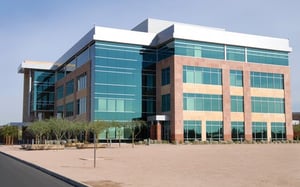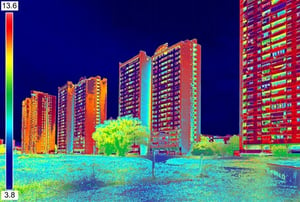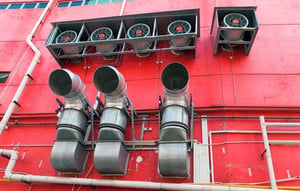Share this
What Facility Managers Need to Know About Load Shifting - Part 1
by Phoenix Energy Technologies on Oct 21, 2019
For most building and facility managers, maintaining comfort and reducing energy and capital equipment costs is high on their list of priorities. Achieving this involves identifying and resolving equipment issues that can negatively impact building efficiency, thus reducing comfort, increasing operating costs and capital expenditure.
Today, the pursuit of an energy-efficient infrastructure, is forcing organizations to explore ways to efficiently reduce energy waste and corporate carbon footprints. As such, they can no longer afford to dismiss the untapped energy and facilities savings that exist across their building portfolios.
What is Adaptive Energy Management (AEM)?
Since HVAC systems take up a large part of a building’s energy consumption, it stands to reason that facility managers should look for ways to make sure that their HVAC systems are running as efficiently as possible, in order to reduce energy use.
 In a bid to lower energy usage, and save costs, some facility managers set, non-standard higher temperature setpoints both when their buildings are occupied and unoccupied. However, this neither saves money nor energy. Doing so actually places more stress on the system since it ends up working outside of its original design criteria, failing to ever make occupied setpoint during peak heat periods, leading to increased wear and tear, even more energy usage during peak demand times, and more equipment breakdowns, hot calls, truck rolls and maintenance costs.
In a bid to lower energy usage, and save costs, some facility managers set, non-standard higher temperature setpoints both when their buildings are occupied and unoccupied. However, this neither saves money nor energy. Doing so actually places more stress on the system since it ends up working outside of its original design criteria, failing to ever make occupied setpoint during peak heat periods, leading to increased wear and tear, even more energy usage during peak demand times, and more equipment breakdowns, hot calls, truck rolls and maintenance costs.
To reduce energy spend, facility managers need to understand load shifting and thermal mass cooling and how they can leverage these concepts to maximize building efficiency.
Adaptive Energy Management - How to Use Your Buildings as a Battery
What is Load Shifting?
Raising the setpoints by an extreme amount, > 4 - 5 degrees, when the building is unoccupied isn’t a good idea because, not only does your HVAC system continue to work even harder during peak periods to reach the occupied setpoint, the building also stores up additional heat throughout the night.
 During the day, cooling units have to work extremely hard to achieve the occupied setpoint. However, it never reaches this point because the building was allowed to overheat during the night and HVAC systems do not have the cooling capacity to quickly overcome the initial heat load stored in the thermal mass of the building.
During the day, cooling units have to work extremely hard to achieve the occupied setpoint. However, it never reaches this point because the building was allowed to overheat during the night and HVAC systems do not have the cooling capacity to quickly overcome the initial heat load stored in the thermal mass of the building.
Load shifting isn’t about increasing the intrinsic efficiency of the RTU (rooftop air conditioning unit). It, however, reduces the heat load on the building and shifts dealing with the majority of the remaining heat load to a more efficient time, when it’s cooler outside.
You should start the system up early and/or run it periodically overnight (when energy costs are low) to reduce the heat stored in a building’s thermal mass, making it easier to achieve the setpoint when the building is occupied during the day.
What is Thermal Mass Cooling?
 If your building overheats during the night, no amount of cold air coming from your RTU is going to make a difference. This is because the RTU only cools the air coming down and does nothing about the heat energy contained in the beams, floor slab, metal girders, and supports of the building.
If your building overheats during the night, no amount of cold air coming from your RTU is going to make a difference. This is because the RTU only cools the air coming down and does nothing about the heat energy contained in the beams, floor slab, metal girders, and supports of the building.
Essentially, the core objective of thermal mass cooling is to use the building itself to reject heat energy. The building is used as a “battery” of sorts to store cold energy during the night (when loads on the HVAC system is low because of the cooler night air and energy is cheap).
The process of thermal mass cooling is a core concept in Adaptive Energy Management. AEM focuses on cooling the building infrastructure and contents down so they can be used to store “cold” energy, enabling it to overcome radiant sun energy during the day.
For part 2 of this post series, click here.
Posts in this series
Adaptive Energy Management Guide
Are You Managing Your Energy Spend?
4 Common Myths of Energy Conservation in Building Management
Precision Building Management: Understanding Closed Loop Control
Share this
- Facilities Management (91)
- Energy Management (69)
- Company News (49)
- Smart Buildings (37)
- Retail (36)
- Building Management (24)
- Building Automation Systems (21)
- Sustainability (20)
- Energy Demand Management (19)
- EEI (15)
- Adaptive Energy Management (14)
- Grocery (14)
- demand response (14)
- Artificial Intelligence (12)
- Data Integration and Visibility (10)
- HVAC IQ (9)
- COVID-19 (8)
- Customer Spotlight (8)
- Carbon Management (7)
- Setpoints and Temperatures (7)
- Equipment Maintenance (6)
- Operational Efficiency (6)
- Refrigeration Optimization (6)
- Ask Ron (5)
- Asset Manager (5)
- Finance and Procurement (5)
- IoT and Digital Transformation (5)
- Awards (4)
- Comfort (4)
- Energy & Store Development (4)
- Safety and Compliance (4)
- Demand Charge Management (3)
- Energy Management System (3)
- Lifecycle Asset Management (3)
- Premium Services (3)
- Refrigeration IQ (3)
- Automated Demand Response (2)
- ConnexFM (2)
- Customer Service (2)
- HVAC Vendor Management (2)
- Load Shedding (2)
- Technician View (2)
- AIM Act (1)
- ALD (1)
- Analytics (1)
- Data (1)
- Data Integration and Visualization (1)
- EMS (1)
- Knowledge Center (1)
- OSHA (1)
- asset management (1)
- December 2025 (1)
- November 2025 (1)
- October 2025 (2)
- September 2025 (1)
- August 2025 (3)
- July 2025 (1)
- June 2025 (1)
- May 2025 (2)
- March 2025 (2)
- February 2025 (1)
- January 2025 (2)
- December 2024 (2)
- October 2024 (1)
- September 2024 (1)
- August 2024 (2)
- June 2024 (2)
- April 2024 (2)
- March 2024 (2)
- January 2024 (1)
- December 2023 (1)
- October 2023 (2)
- September 2023 (2)
- August 2023 (2)
- July 2023 (1)
- May 2023 (2)
- April 2023 (2)
- March 2023 (3)
- February 2023 (1)
- January 2023 (1)
- December 2022 (1)
- November 2022 (2)
- October 2022 (2)
- September 2022 (1)
- May 2022 (2)
- April 2022 (1)
- March 2022 (3)
- February 2022 (2)
- January 2022 (4)
- December 2021 (2)
- November 2021 (3)
- October 2021 (1)
- September 2021 (3)
- August 2021 (4)
- July 2021 (1)
- June 2021 (2)
- May 2021 (1)
- January 2021 (2)
- December 2020 (2)
- November 2020 (2)
- October 2020 (3)
- September 2020 (4)
- August 2020 (3)
- July 2020 (2)
- June 2020 (3)
- May 2020 (3)
- April 2020 (5)
- March 2020 (5)
- February 2020 (4)
- January 2020 (4)
- December 2019 (4)
- November 2019 (3)
- October 2019 (4)
- September 2019 (5)
- August 2019 (4)
- July 2019 (4)
- May 2019 (2)
- April 2019 (3)
- February 2019 (1)
- December 2018 (1)
- November 2018 (1)
- October 2018 (3)
- September 2018 (3)
- August 2018 (3)
- July 2018 (3)
- June 2018 (3)
- May 2018 (1)
- June 2015 (1)
- March 2013 (1)
- January 2013 (1)
- December 2011 (1)
- October 2011 (1)
- September 2011 (1)


